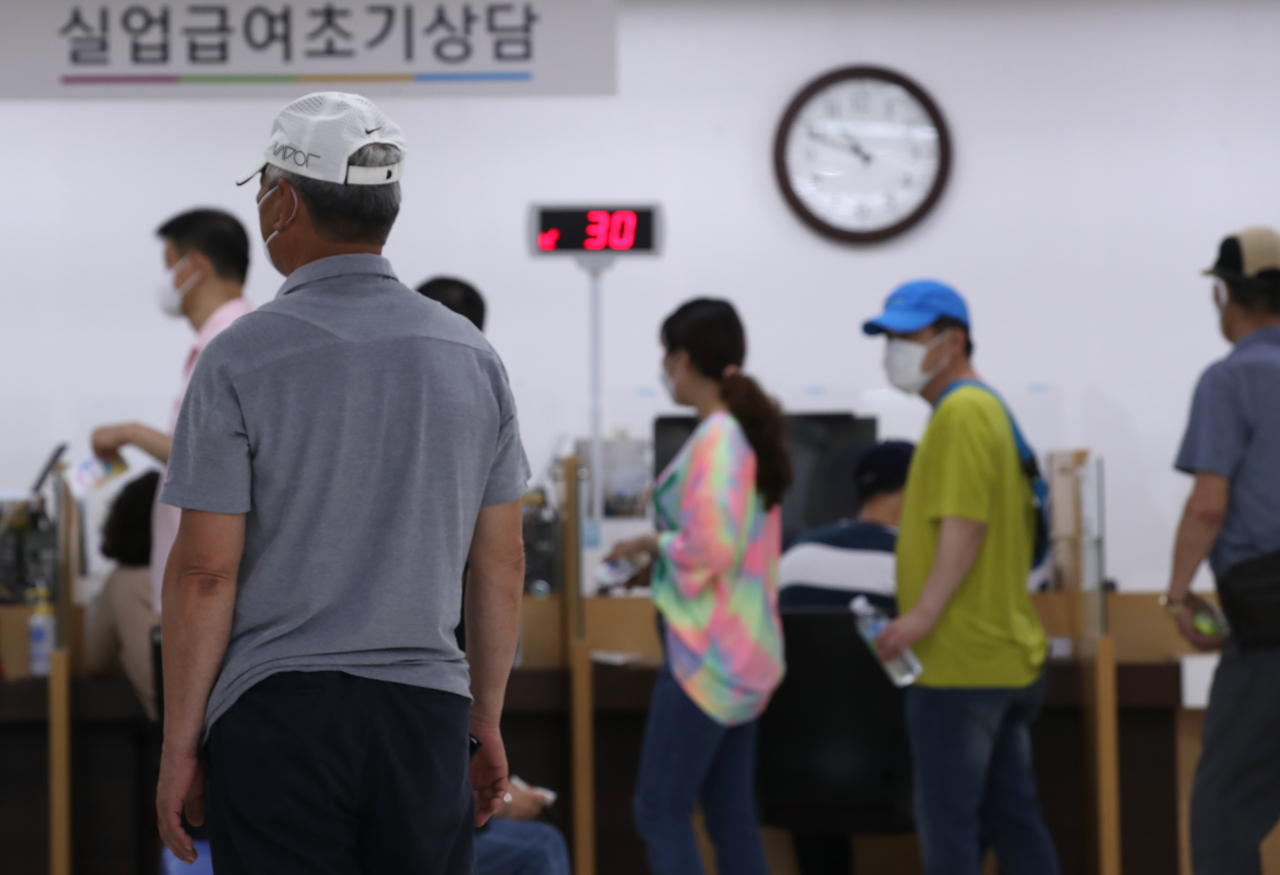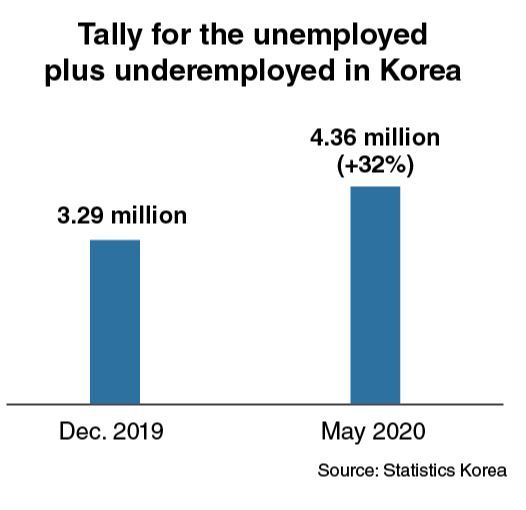[News Focus] 1 in 7 Koreans de facto jobless since March
Number of ‘extended-based’ unemployed up 1 million since Jan. 1
By Kim Yon-sePublished : June 18, 2020 - 16:58

SEJONG -- The novel coronavirus has created a tough job market in which more than 4 million South Koreans have been unemployed or underemployed for a third consecutive month.
According to Statistics Korea, the “extended-based” jobless rate under the Supplementary Index III for Employment stayed above 14 percent over the past three months -- 14.4 percent in March, 14.9 percent in April and 14.5 percent in May.
This is an unprecedented high, indicating that 1 out of 7 Koreans has been de facto jobless, meaning underemployed or out of work. The COVID-19 pandemic hit the nation hard in February and March after the first case was recorded Jan. 20.
The Index III provides a relatively new method of calculating unemployment, counting underemployed people among the de facto unemployed. This category includes those who work fewer than 36 hours a week and want to work more, as well as seasonal workers who are out of work for part of the year.
Out of the nation’s economically active population, about 29 million to 30 million on an extended basis, the number of de facto unemployed ranged between 4.2 million and 4.4 million during the three-month period.
A year earlier, the number ranged between 3.6 million and 3.7 million, with the Index III staying at the 12 percent level during the period from March through May 2019. The index also remained in the 12 percent range in January and February 2020.

Compared with the figure at the end of 2019 -- 3.29 million in December -- the number of jobless on an extended basis surged by more than 1 million (32 percent), reaching 4.36 million in May.
The situation is more serious for those aged 15-29, a great number of whom are said to have abandoned their job search amid the COVID-19 woes.
The extended jobless rate under the Supplementary Index III for Employment for the youngest working-age group surpassed 26 percent -- 26.6 percent in March, 26.6 percent in April and 26.3 percent in May. This means 1 of 4 young Koreans is de facto unemployed.
Of the economically active population within that age bracket, 4.89 million, the tally for unemployed or underemployed reached 1.28 million as of May.
Among the sectors hit hardest by the pandemic are tourism, airlines, restaurants, lodging and private educational institutes, which have resorted to layoffs or hiring freezes.
The government’s monthly payouts of unemployment benefits surpassed 1 trillion won ($826.92 million) in May -- the first time since 1995, when the nation began compiling data on the matter.
This is intensifying concerns over the government’s capacity to continue paying benefits at such high levels. Payments had already seen a sharp increase even before the pandemic started, due to increases in the minimum wage and mass closures of small businesses in 2018 and 2019.
According to the Korea Employment Information Service, unemployment benefits have continued to increase sharply on-year over the past three years -- from 5 trillion won in 2017 to 6.43 trillion won in 2018, and to an all-time high of 8.07 trillion won in 2019.
The 2019 figure marked a 72.8 percent (or 3.4 trillion won) surge compared with 2016 under the previous administration, when it was 4.67 trillion won.
Further, compared with five years earlier, in 2014, when benefits paid out amounted to 3.96 trillion won, the 2019 levels constituted a 103.7 percent increase.
The spike in payments could suggest a dire situation in the hiring market under the Moon Jae-in administration.
“Though there were some people who exploited the state-led payout system via shady securing of beneficiary eligibility, data indicated that a growing number of people have been forced to leave their workplaces amid the economic slowdown,” said a research analyst in Seoul.
In the 2020 comparison by the Organization for Economic Cooperation and Development, which looked at all 37 member nations, Korea posted a 66.7 percent employment rate among those aged 15-64 as of the first quarter.
The figure falls short of the OECD average, 68.9 percent, and the average of the Group of Seven, 72.2 percent. Korea ranked 28th, while Japan stood at No. 4 with 78 percent.
By Kim Yon-se (kys@heraldcorp.com)








![[KH Explains] Hyundai's full hybrid edge to pay off amid slow transition to pure EVs](http://res.heraldm.com/phpwas/restmb_idxmake.php?idx=644&simg=/content/image/2024/04/18/20240418050645_0.jpg&u=20240419100350)






![[From the Scene] Monks, Buddhists hail return of remains of Buddhas](http://res.heraldm.com/phpwas/restmb_idxmake.php?idx=652&simg=/content/image/2024/04/19/20240419050617_0.jpg&u=20240419175937)

![[KH Explains] Hyundai's full hybrid edge to pay off amid slow transition to pure EVs](http://res.heraldm.com/phpwas/restmb_idxmake.php?idx=652&simg=/content/image/2024/04/18/20240418050645_0.jpg&u=20240419100350)

![[Today’s K-pop] Illit drops debut single remix](http://res.heraldm.com/phpwas/restmb_idxmake.php?idx=642&simg=/content/image/2024/04/19/20240419050612_0.jpg&u=)